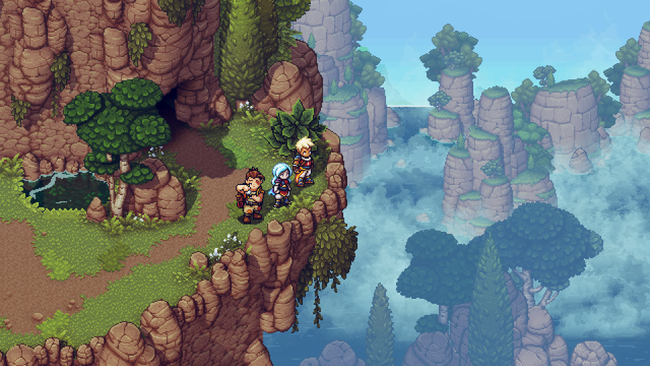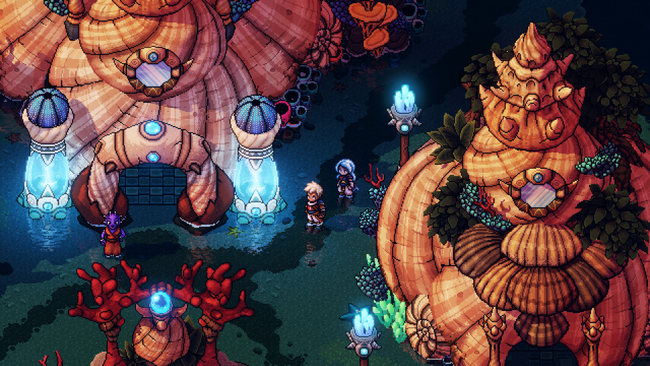
Sea of Stars Review
Revisiting an old favorite is about more than just watching the same movie or reading the same book again. Some people replay the same game or watch the same series on an annual basis, while others may want to refamiliarize themself with a long-lost friend they haven't seen in a while. There’s something romantic about revisiting snapshots of our own history through the lens of what helped define us in those times, and what continues to stick with us many years later. While pop culture and media are teeming with reboots, sequels, remakes, and the like, it’s rare when something new comes along and evokes those feelings of familiarity. Plenty of games bill themselves as being inspired by the SNES classics, but Sea of Stars stands out because it doesn’t just understand how those games look and are played, but also how they feel.
The story sees players choosing between one of two trainees on the cusp of becoming Solstice Warriors: Zale, the solar blade dancer, or his friend Valere, a lunar monk. The game starts at the beginning of a rite of passage before a brief flashback into their decade of training. As Zale and Valere become Solstice Warriors, they are given a mission to destroy the woe dweller, a creation of a wicked sorcerer known only as the Fleshmancer. Before long, the pair are drawn into a conflict between Solstice Warriors that expands not only across their world, but the worlds and timelines of others.

It is clear from the onset Sea of Stars revels in JRPG tropes, leaning into them with a loving wink. The characters are embodiments of archetypes, but the characterization is fresh, and buttressed by sharp writing. Likewise, while the game hits familiar beats, it frequently subverts expectations with its narrative. The game is always in on the joke but never crosses the line into cloying. There is even a supporting character who all but breaks the fourth wall when discussing story developments, but in a cheeky way.
It’s this attitude - and masterful execution - that sets Sea of Stars apart from similarly situated “retro-inspired” turn-based RPGs. It wears influence on its sleeves - set pieces, combo attacks, and even some enemies are immediately recognizable as inspired from Chrono Trigger. Even then, players can project their favorite 1990’s era JRPG as an ancestral inspiration for this title. Did you grow up playing Breath of Fire, the PlayStation ports of the Lunar games, Illusion of Gaia, or any of its ilk? Because the team at Sabotage did, and their careful study of not only how those games played, but also how they felt rings as wholly genuine.
This academic study is no more clear than in battle, which serves as a melting pot of the genre's best gimmicks. The turn-based encounters start off slowly, onboarding the player with timed attacks, charged attacks, and an innovative lock system, whereupon players can cancel an enemy's pending attack by executing a series of elemental or weapon-type attacks before the enemy's next turn. As the party grows, team combo attacks are introduced, with more than a few callbacks to Chrono Trigger. As a result, combat is challenging without being overwhelming, requiring your attention and expecting effective use of abilities and charged attacks to prevail.

With six total party members, swapping members in combat is a breeze. Managing your party is also intuitive, with all characters leveling up together- when Zale levels up, so does Valere and the rest of the crew, with players able to choose a specific stat bonus for each member, too. There are no random encounters in Sea of Stars. Instead, encounters are fixed in specific locations on each map, eliminating the need for grinding. There are also obtainable artifacts that can be toggled to modify difficulty or remove some of the timing components from battle for those who would prefer or even require it. These design choices are intentional and thoughtful, and just another way the game respects the player’s time.
Valere and Zale explore the world with aplomb as they swim and jump through environments, even swinging about using a grappling hook-type device. These segments seamlessly blend together the action-RPG platforming of SNES-era Zelda or Secret of Mana and the intricacies of turn-based combat. While it's no surprise or technical marvel that a game in 2023 can exceed the hardware limitations of 1993, it feels organic and makes the world feel alive. These dungeons and locations are well-designed, offering previews of inaccessible areas that players will be crossing shortly. There are plenty of puzzles in and out of dungeons, requiring strategic use of the grapple, pushing blocks or items into designated locations, or even using the Solstice Warriors ability to change the time of day at will. There isn’t a single dungeon that lasts too long, and instances of backtracking are rare.
There is so much to do in Sea of Stars, but all of it is meaningful or moves the player towards a greater purpose. There is a simple, yet addictive fishing minigame and plenty of fruits and other items to gather. These disparate elements literally synthesize together: while camping, as players can assemble these components into food items that are used as restoratives in and out of battle. Players are incentivized to explore, with recipe cards and combat abilities peppered throughout the map. There's even an extensive tabletop game that is easy to learn but quite difficult to master.

While already delivering in terms of story and combat, presentation is where Sea of Stars truly shines. The sights and sounds are simply exquisite. The primary composer, Eric W. Brown really captures the essence of the genre while infusing it without modern flourishes that create an endlessly replayable soundscape. His work is stellar, and it's a testament to his work that guest tracks from acclaimed Yasunori Mitsuda sound right at home. The combat themes stand out, and I particularly enjoyed the different arrangements of the main battle theme that reflected the character’s current location.
The graphical presentation exhibits a lovely art style, especially with the detailed sprite work. Watching the characters simply shifting in battle is delightful, not even mentioning the brilliant ultimate attack animations for each character or the frequently gigantic boss animations. The lighting is simply gorgeous, either while watching Zale change the time of day or when executing a gorgeously animated ability. Combine these with detailed backgrounds and charming maps, and Sea of Stars captures the essence of the retro JRPGs without relying on HD-2D or fake CRT-scan lines.
There were so many times during Sea of Stars when I felt as if I was replaying a longtime favorite - in the best way possible. The music felt familiar, as did the combat, characters, and story beats. Even better, so many of the quirks or minor irritants from these games have been mitigated, with little backtracking or cumbersome item management. There have been plenty of games that are designed to replicate a vintage aesthetic or battle system, but feel insincere or have nothing new to say about the genre. Sea of Stars shines a light on the classics but through a lens of modernity.

That's part of the reason Sea of Stars is such a success. It leans on the past without being shackled to it, taking elements from the classics while adding technical flourishes to liven up the proceedings. It doesn't simply try to copy the classics or provide a facsimile of a retro experience. Instead, it recreates the experience of feeling those games, allowing us to revisit what it felt like to perceive the spectacle and grandeur for the first time. By those measures, Sea of Stars might be inspired by the classics, but it feels in league with them, too.